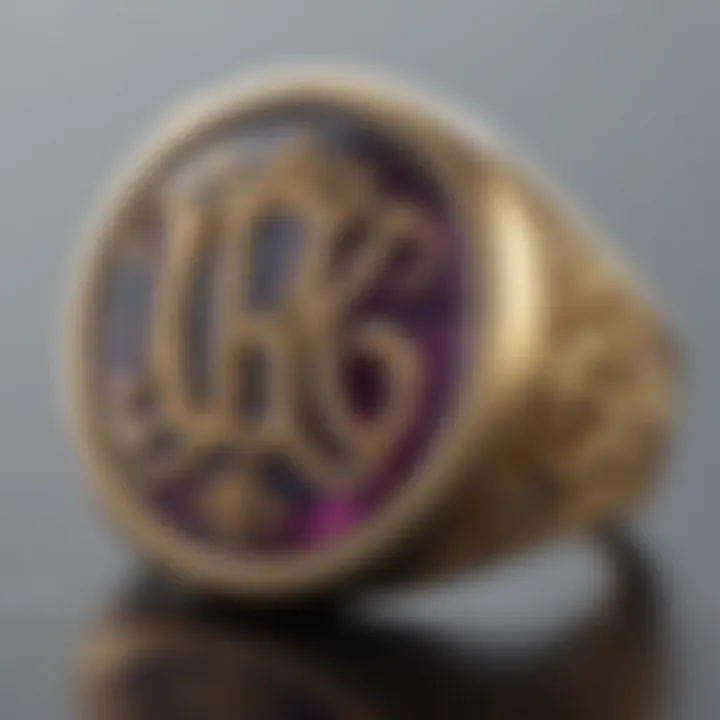The Art and Craftsmanship of Signet Rings


Intro
Signet rings have been a significant part of jewelry history, symbolizing status, identity, and tradition. This article delves into the art and craftsmanship involved in creating these rings, examining their historical roots and the meticulous techniques used in their manufacture. Signet rings blend artistry with practicality, allowing for personal touches that reflect individual heritage. Understanding the intricacies of their creation reveals not only the beauty of signet rings but also their cultural importance.
Gemstone Overview
Gemstones are precious or semi-precious stones that are often used in jewelry. They possess distinct qualities, such as brilliance, color, and durability, making them desirable for various applications, including signet rings.
Definition of Gemstones
A gemstone can be defined as a cut and polished mineral crystal that is prized for its beauty and rarity. They are often used in decorative arts, and their appeal can stem from their luster, clarity, and brilliance. In the realm of signet rings, gemstones serve as an essential component, often acting as a focal point of design.
Classification of Gemstones
Gemstones may be classified into two main categories:
- Precious Stones: This group typically includes diamonds, rubies, sapphires, and emeralds. These stones are known for their remarkable aesthetics and high value.
- Semi-Precious Stones: Includes a wide variety of stones such as amethyst, garnet, and citrine. While not deemed as rare as precious stones, they possess unique characteristics and appeal.
Understanding these classifications helps in selecting the right gemstone for a signet ring, considering factors like durability and aesthetic appeal.
Historical Significance
The history of gemstones is rich and complex, closely tied to human culture. Signet rings have held a place in society since ancient times, often associated with authority and signify personal identity.
Origins of Gemstone Use
The use of gemstones dates back thousands of years. In many ancient civilizations, gemstones were thought to possess powers or protective qualities. They were often used in religious practices, royal insignia, and personal adornment. The tradition of embedding gemstones in personal adornments like rings emerged from these historical contexts.
Cultural Insights: Gemstones in Ancient Civilizations
- In ancient Egypt, gemstones like lapis lazuli and turquoise were used in jewelry and burial artifacts.
- The Romans adopted gemstones for signet rings, associating them with power and influence. A signet ring adorned with a unique carving allowed for personal identification when sealing documents.
The historical journey of gems reflects not merely ornamental use but also their societal roles in identity and status. This understanding enhances the significance of gemstones when crafting contemporary signet rings.
Prelude to Signet Rings
The craftsmanship of signet rings extends beyond mere ornamentation. These rings possess a blend of functionality and artistry that has captivated cultures for centuries. Understanding the significance of signet rings is essential, as they have served as symbols of identity, authority, and personal expression.
Defining Signet Rings
Signet rings are often characterized by their engraved designs, which are visible when pressed into wax or clay. Unlike standard rings, a signet ring typically features a flat surface, allowing for detailed personalization. This unique form sets them apart, making signet rings a favored choice among those seeking individuality in their jewelry.
Historical Context
Historical context greatly enhances the appreciation of signet rings. By examining their origins and societal roles, one gains deeper insights into their enduring appeal.
Ancient Origins
The origins of signet rings can be traced back to ancient civilizations such as Egypt, Mesopotamia, and Greece. They were commonly used as seals, stamped into documents to authenticate and signify ownership. This functionality is a key characteristic of ancient signet rings, establishing them as both practical and revered objects.
In today’s context, understanding their ancient usages is beneficial for grasping the historical weight these rings carry. They were not just personal adornments but crucial tools for communication and commerce, often indicating the wearer’s lineage or status within society.
Use in Society
In society, the role of signet rings has expanded beyond mere symbolism. They were often bestowed as gifts or family heirlooms, enhancing interpersonal bonds and conveying significance across generations. A prominent feature is their association with nobility and authority, which persists to this day.
The societal functions of signet rings remain relevant. In recognizing their historical roots, one can appreciate the continuous threading of personal identity and communal legacy they foster. This makes signet rings an attractive choice for modern users looking to link personal expression with tradition.
Evolution Through the Ages
Throughout history, signet rings have evolved in design and purpose. From the rich materials and intricate engravings of the Renaissance to the minimalist styles of the contemporary era, signet rings have adapted to reflect changing aesthetic and cultural values.
This evolution is significant for contemporary artisans and jewelry makers. The ability to fuse traditional craftsmanship with modern design allows for a broader appeal among diverse consumer bases. Notably, it offers the advantage of retaining historical prestige while catering to current tastes.
In summary, the history of signet rings is intricate and multifaceted. From their ancient origins to modern interpretations, they continue to embody a rich legacy of artistry and identity. The exploration of these origins lays a solid foundation for appreciating the craftsmanship and artistry involved in creating signet rings today.


Materials Utilized in Signet Ring Creation
The selection of materials is fundamental in crafting a signet ring. Each material carries its own characteristics, influencing the final product's appearance, durability, and value. The choice of metals and gemstones impacts not only the ring's aesthetic but also its significance and usability.
Types of Metals
Gold
Gold has long been favored for its lustrous appearance and innate value. It is malleable, allowing artisans to create intricate designs and engravings. Its durability is a key factor; gold does not tarnish, which means a well-made gold signet ring can last a lifetime. However, gold is softer than some other metals, making it more prone to scratches.
Advantages of gold include its rich history and sentimental value. It is often associated with wealth and status. On the downside, the price can be prohibitive for some, particularly for larger pieces.
Silver
Silver is another popular choice, known for its bright and shiny finish. This metal is less expensive than gold, making it accessible to a broader audience. Its versatility allows for creative designs, and silver can be easily engraved. However, it is more prone to tarnishing over time, requiring regular maintenance to keep it looking its best.
The main advantage of silver is its affordability and aesthetic appeal. It allows for personal expression without significant financial investment. Nevertheless, its maintenance can be seen as a disadvantage, as owners must take care to prevent tarnishing.
Platinum
Platinum is a premium choice for signet rings, valued for its strength and resistance to wear. It is heavier than gold and silver, contributing to a feeling of quality and luxury. Platinum does not tarnish, making it low-maintenance compared to silver. This metal is ideal for those seeking something durable yet elegant.
Its primary benefit lies in its rarity and robust nature. However, it is significantly more expensive than other metals, which can limit its appeal. The high skill necessary for working with platinum may also make it less accessible for some artisans.
Gemstones for Signet Rings
Precious Stones
Precious stones, such as diamonds, rubies, sapphires, and emeralds, are traditional choices for signet rings. Each stone carries unique meanings and can personalize the ring immensely. They are often seen as status symbols, enhancing the ring’s overall value. The main downside is the higher cost compared to alternative gemstones.
The brilliance and durability of precious stones can make them a worthwhile investment, but their pricing makes them less accessible for some.
Alternative Gemstones
Alternative gemstones offer an interesting option for those looking for uniqueness. Stones like amethyst, aquamarine, or even lab-created gems can provide a distinct look at a more affordable price. These alternatives allow for personal expression and individuality, often appealing to a younger audience.
The primary advantage of alternative gemstones is their uniqueness and lower cost. However, some may see them as less prestigious compared to traditional precious stones.
Ethical Sourcing
Ethical sourcing has become increasingly important for consumers today. More people are interested in the origins of materials used in their jewelry. Choosing ethically sourced gemstones ensures that the stones were collected in ways that respect human rights and the environment.
This consideration is especially relevant for signet rings, as these pieces often hold significant emotional value. Ethical sourcing also appeals to a clientele that is conscious about sustainability. The downside is that ethically sourced gemstones may come at a higher price, impacting affordability.
Design Considerations
Design considerations play a crucial role in the crafting of signet rings. They influence not only the aesthetics but also the functionality and personal meaning behind the piece. When creating a signet ring, one must evaluate the overall style, engraving techniques, and the unique symbolism that will represent the wearer. All these elements work together to create a piece that is not only visually appealing but also deeply personal.
Choosing the Ring Style
Classic vs. Contemporary
The distinction between classical and contemporary styles is essential when selecting a signet ring. Classic designs often feature traditional shapes and insignias that resonate with historical symbols of nobility and heritage. This approach favors timeless materials and detailed craftsmanship.
In contrast, contemporary styles offer a more modern interpretation. These often incorporate innovative shapes and materials, appealing to those looking for uniqueness in their jewelry. The key characteristic of classic styles lies in their enduring appeal. They often evoke a sense of continuity and connection to the past.
Contemporary designs, however, stand out for their fresh aesthetics that embrace current trends. This uniqueness helps personalize the ring for the wearer, allowing expression of individual style. One disadvantage of contemporary designs can be that they may not have the same lasting significance as classic designs, which have established their worth over centuries.
Cultural Influences
Cultural influences greatly inform the design choices for signet rings. Different cultures have specific symbols or motifs that hold significance. For instance, in some European cultures, family crests are used. In other cultures, specific animals or geometric shapes are prevalent. These attributes can add layers of meaning to the ring, enhancing its personal connection to the wearer.
The key feature of incorporating culture into design is the deep-rooted significance it can convey. When someone wears a ring that reflects their heritage, it can foster a sense of identity and belonging. However, a challenge comes when the symbolism may not resonate as deeply for others outside the culture. Understanding this can be crucial for the designer and the wearer.
Engraving Techniques
Types of Engravings


Engraving serves as an essential aspect of customizing signet rings. Different engraving styles can create varying levels of texture and intricate designs. Traditional techniques like hand engraving provide a one-of-a-kind appearance. On the other hand, laser engraving offers precision and can accommodate complicated designs that might be hard to achieve by hand.
The main characteristic of these types of engravings is their ability to personalize the piece further. While hand engraving can create a more artisanal feel, laser engraving can ensure fine details are captured more precisely. However, hand engraving may take longer and can potentially yield slight variations, which some may view as an advantage in uniqueness.
Customization Options
Customization is a prominent factor in the appeal of signet rings. From gemstone choices to metal finishes, the possibilities are extensive. Customization enables the wearer to reflect personal story or aesthetics. This characteristic can result in unique designs that are significant only to the individual.
However, customization can also lead to decision fatigue for some. The vast array of choices can be overwhelming and may complicate the design process. Nevertheless, the end result often justifies the effort, delivering a deeply personal jewelry piece.
Symbolism in Design
Symbolism in signet ring designs takes various forms, acting as a visual representation of beliefs or values held by the wearer. Common symbols may include crests, partnerships, or individual values like love and loyalty. This emphasis on significance is crucial, as it differentiates personal items from mere fashion statements.
The unique feature of symbolism in design enhances the ring's emotional connection. When someone wears a ring with a significant symbol, it often serves as a reminder of personal stories or family heritage. Yet, it can also pose a challenge if the meaning is not universally understood by others, potentially leading to misinterpretation.
In summary, every design consideration enriches the signet ring's narrative, weaving together historical significance, personal expression, and cultural identity.
The Creation Process
The creation process is a pivotal aspect of crafting signet rings. It encompasses various stages that transform raw materials into intricate pieces of wearable art. Understanding this process is essential for appreciating the craftsmanship involved and the care taken in producing each ring. The journey begins with conceptualization and carefully proceeds through design, materials selection, and skilled labor to bring visions to life. Each step is critical to ensure quality and authenticity, making the final product a true representation of personal style and tradition.
Sketching and Prototyping
Sketching and prototyping lay the foundation for creating a signet ring. This stage involves translating ideas into visual representations. Sketches serve both as a design blueprint and a guide for the craftsman. They help identify proportions, details, and overall aesthetics before any material is touched.
Prototyping is the next logical step, where initial sketches are brought to three-dimensional life, often using non-precious materials for trials. It allows for adjustments based on fit and comfort, which is essential before final production begins. This iterative process fosters creativity and refinement, ensuring the final piece reflects the intended design.
Metalworking Techniques
Metalworking encompasses the skills and techniques used to shape and manipulate metals used in signet rings. This process not only involves shaping the metal but also infusing artistic elements into its form through various methods. Among the significant techniques are forging and shaping, as well as polishing and finishing.
Forging and Shaping
Forging and shaping are core components of metalworking when creating signet rings. This technique involves applying heat and force to metal. It allows artisans to create the desired form while enhancing the material's strength through compression. One key characteristic of forging is its ability to produce a homogeneous structure, important for durability and longevity.
Additionally, the uniqueness of each forged piece can add character to the ring, setting it apart from mass-produced alternatives. This method is beneficial because it reduces the likelihood of weaknesses within the metal. However, forging requires significant skill and experience. The artisan must understand how different metals respond to heat and manipulation, ensuring that the desired outcome is achieved without compromising integrity.
Polishing and Finishing
Polishing and finishing are crucial steps in the creation process, affecting the final appearance of the signet ring. Polishing involves smoothing the surface of the metal, eliminating imperfections, and enhancing its luster. A well-polished ring presents a high-quality look, reflecting craftsmanship.
The key characteristic of this technique is that it transforms raw, potentially dull metal into a stunning, sleek surface that attracts attention. This step is vital for aesthetic appeal, making it a popular choice among both artisans and collectors.
However, polishing must be executed with care, as over-polishing can wear down intricate designs or affect engravings. The finishing touches often involve applying protective coatings, which not only enhance durability but can also influence the color and brightness of the metal. Overall, these techniques contribute significantly to the overall quality and desirability of the final signet ring.
Post-Creation Considerations
Post-creation considerations are vital to the long-term beauty and functionality of signet rings. Once a signet ring is crafted, care and maintenance ensure its preservation. These steps can prevent damage and keep the ring looking as exquisite as the day it was acquired. Understanding proper handling and care allows the owner to appreciate their investment fully.
Caring for Your Signet Ring
Cleaning Methods
Cleaning methods are essential to maintaining the shine and preventing tarnish or scratches on signet rings. Regular cleaning contributes to the overall aesthetic appeal of the ring, ensuring it remains a cherished accessory. The key characteristic of effective cleaning methods lies in their simplicity and efficacy.
A commonly favored method involves using mild soap and warm water. This beneficial choice is safe for all types of metals and stones typically used in signet rings. The unique feature of this method is its accessibility; anyone can implement it with basic materials found at home. Advantages include removing dirt and oil, at the same time ensuring a gentle approach that minimizes wear on the surface.
However, it is worth noting that sharper cleaning agents or rough cloths can cause damage, so caution is necessary. Regular cleaning, approximately every few weeks, can keep the signet ring in pristine condition.
Storage Solutions
Storage solutions play an integral role in preserving the integrity of a signet ring. Proper storage can prevent scratches or misshaping that may occur when rings are left unchecked. A key characteristic of effective storage is the ability to keep the ring isolated from other jewelry, thereby minimizing contact.
Using a soft-lined jewelry box or a dedicated ring pouch is a beneficial choice for safeguarding the piece. These options often feature compartments that prevent tangling or scratching against other items. The unique feature of these storage solutions is their ability to maintain the ring's original condition over time, offering safety against environmental factors.
The disadvantage might include the necessity to remember where the ring is stored, which can lead to misplaced jewelry if not returned to its designated place after use.


Repair Options
When to Seek Professional Help
Seeking professional help is an important consideration for maintaining signet rings. There are times when DIY methods may not suffice, especially in cases of significant damage or if the ring requires resizing. The key characteristic of professional help is access to specialized knowledge and tools that can address issues beyond basic care.
Engaging a reputable jeweler is often a beneficial choice, as they can provide insight into the material and design nuances specific to the ring. The unique feature of consulting a professional is that it offers peace of mind, knowing that the repair will be completed to high standards, preserving the ring's structural integrity and aesthetic value.
However, this option can involve costs, so understanding when to take this step is crucial.
DIY Maintenance Tips
DIY maintenance tips allow signet ring owners to extend the lifespan of their jewelry with simple practices. These tips can cover various areas, such as gentle cleaning and regular inspections for loose stones. The key characteristic of DIY maintenance is its accessibility; these practices are actionable and require minimal tools or products.
For example, using a soft toothbrush to gently scrub the crevices can be a beneficial choice for preventing the buildup of dirt without harming the finish. This method not only enhances the appearance but also engages the owner in the maintenance process, fostering a deeper appreciation of the craftsmanship.
However, the unique feature of DIY maintenance tips is the slight risk of overzealous cleaning that might lead to scratching or loosening parts. Thus, caution is always advised.
"Investing effort into the care of signet rings is essential for preserving their beauty and significance over time."
Overall, post-creation considerations for signet rings emphasize the significance of diligent care, appropriate storage, and understanding when to seek professional assistance.
Signet Rings in Contemporary Society
In today’s world, signet rings have transcended their traditional roles and emerged as significant symbols of personal expression and cultural heritage. They now serve not only as functional pieces of jewelry but also as reflections of individual identity, family lineage, and status. The contemporary landscape for signet rings is rich with possibilities that blend history with modern aesthetics.
Trends in Signet Ring Design
Currently, there are several noteworthy trends in signet ring design which cater to diverse tastes and interests. Many designers are incorporating influences from both classic and avant-garde styles, offering unique forms that cater to individual preferences. The following trends dominate the current market:
- Personalization: Custom engravings have become popular, allowing consumers to add meaningful symbols or initials, creating a personal connection to the piece.
- Mixed Materials: Instead of traditional metals, designs often incorporate elements like wood or resin, enhancing the visual appeal and texture of the ring.
- Bold Shapes: The geometric forms are trending, breaking away from the classic oval shape typically associated with signet rings, bringing freshness to the design.
These trends not only showcase the artistry involved in creating signet rings but also reflect broader cultural themes where personal expression and identity are celebrated.
Significance of Signet Rings Today
In the modern context, the reasons for owning a signet ring are varied and rich. They function not only as jewelry but as powerful symbols of identity and personal history.
For Personal Identity
The aspect of personal identity in signet rings is significant. They often serve as a vehicle through which individuals can express their personal stories or affiliations. This is particularly relevant for those who might choose to engrave meaningful symbols or monograms. The distinctive nature of a signet ring allows it to stand out as a conversation starter, establishing a unique branding for its wearer. The individuality of each design plays a crucial role in the appeal of these rings now. While they can showcase beauty, they also embody personality, character, and life experiences. People are drawn to this connection and the idea of wearing something that truly reflects who they are.
As Family Heirlooms
Beyond personal identity, signet rings are cherished as family heirlooms, linking generations through tangible artifacts. Owning a signet ring that has been passed down carries emotional weight, representing family lineage and tradition. These heirlooms often bear unique engravings that hold stories of the past, making them highly valued possessions.
Moreover, signet rings as heirlooms can also serve as a beneficial legacy for future generations. When properly maintained, they can remain in pristine condition for years, allowing descendants to inherit a piece of history. Families often create rituals around passing these rings, reinforcing family bonds and values.
However, there can be drawbacks to consider. The emotional ties to the rings may lead to pressure on heirs to preserve them. And if a ring is lost or damaged, it can result in a significant emotional setback.
Ending
The conclusion of this article emphasizes the craftsmanship involved in creating signet rings and their enduring significance in both historical and modern contexts. Signet rings are not merely ornamental pieces; they symbolize legacy, identity, and heritage, bridging past and present. The intricate methods involved in their creation, from material selection to personal customization, render them unique reflections of individual style and legacy.
Summarizing the Craftsmanship
The craftsmanship of signet rings centers around a blend of artistry, skill, and historical meaning. Each ring is a statement, shaped through meticulous processes that require both precision and creativity. From the choice of durable metals like gold or platinum to the selection of gemstones, every element is curated with intent. Engraving designs further personalizes these pieces, allowing wearers to express their individuality or familial ties.
These efforts are not only about aesthetics. They reflect a cultivated understanding of material properties and techniques, highlighting the artisan’s knowledge. Individuals who own signet rings often cherish them, as these adornments carry emotional resonance, telling stories from the past while enhancing the present.
Future Directions
Adapting to Modern Trends
As society shifts, so does the design of signet rings. Recent trends lean towards minimalist aesthetics and sustainable materials. Consumers now favor rings that reflect modern sensibilities while respecting tradition. This blending of new and old creates a unique appeal. Modern designs often embrace clean lines and subtle details, which resonate well with contemporary tastes. The significant characteristic of adapting to modern trends is its ability to attract a younger demographic interested in personal expression through jewelry. However, this shift does present the challenge of ensuring that traditional craftsmanship is not lost in pursuit of trend.
Preservation of Traditional Techniques
On the other hand, preserving traditional techniques is crucial in maintaining the authenticity of signet rings. Methods such as hand engraving or die striking offer a level of detail and character that modern techniques may lack. The key characteristic of preserving these techniques is the emphasis on artistry rather than purely mechanistic production. Celebrating these methods keeps the art of signet ring making alive, ensuring that future artisans learn the skills needed to create intricate, timeless pieces.
These traditional practices often evoke a sense of nostalgia and authenticity, adding depth to the craftsmanship. A potential downside, though, lies in the longevity of such techniques in a rapidly evolving market driven by technology and fast fashion. Thus, a balance must be struck between embracing modernity and honoring the craftsmanship of the past.
The future of signet rings lies in the harmonious blend of traditional craftsmanship and modern trends, celebrating both history and personal expression.



